Bitcoin hardware wallets are an area of digital currency security still very much in its experimental phase. Developers are striving to offer the most advanced security features in the most accessible way possible, but the complexity of the undertaking often results in misunderstandings on the part of the consumer.
With this in mind, Cointelegraph sought to provide a summary of the credentials of the main hardware wallet products on the market today. Included are the major offerings which are either already available or in the final stages of development with release imminent.
The products under review are:
- Bitcoincard (Mycelium)
- Bitsafe (Butterfly Labs)
- BitStash
- BTChip HW-1
- Pi Wallet
- Trezor
Of these, Bitsafe and Bitcoincard are currently still in development, with BitStash due for release in May 2015.
Bitcoincard (Mycelium)
How it works
Bitcoincard is unique in using radio signals to request information from the Bitcoin network about transactions. The card works in conjunction with a gateway, which comes in two forms, to communicate transaction information securely.
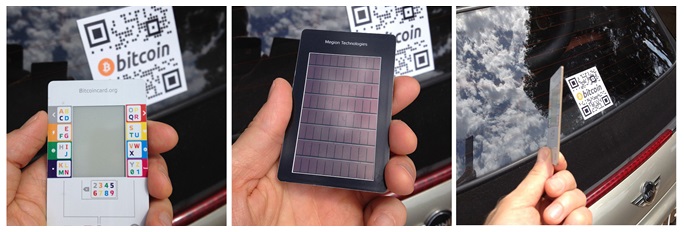
The gateway in turn communicates with a server to complete the connection between the card and the network. The card itself can only communicate with other devices via radio signal.
Gateways are available as a separate device with an Ethernet cable, or as a USB dongle with attached aerial for use with portable devices such as notebooks.
It is also possible to transfer coins from one card to another without the need for a server. Doing so will create unconfirmed transactions which are then verified once server connection is reestablished.
Security features
Information protection: Digital signature keys are created and stored on the card, and are never sent to other components.
Hacker potential: The card does not involve an operating system and cannot download software, resulting in basically nonexistent risk of cyber theft.
Loss/ theft protection: None. If the card is lost, the BTC balance is irrecoverable.
Price and availability
As yet, no official information has been released by Mycelium regarding cost or potential release date for the hardware wallet.
Ease of use and feedback
Owing to no production examples being available or rumored to be available, there has so far been no feedback on using the device.
Bitsafe (Butterfly Labs)
Mining company Butterfly Labs is due to launch its first hardware wallet solution in the near future following a considerable development period.

How it works
While full specifications have yet to be released pending finalization of the design, the hardware wallet will primarily feature USB and camera as the main points of connectivity.
Digital private keys will be stored on the touchscreen device, which most likely will be of a size similar to a credit card. Bitsafe will also include support for multisignature transactions.
Bitsafe-to-Bitsafe capabilities will be possible using the integrated camera, which will allow scanning of QR codes, including those displayed on another Bitsafe device.
The current plans also include a micro SD card back-up system to guard against loss or theft of the device. This was originally conceived as a physical paper back-up.
Bitsafe will feature solar charging, allowing the battery to be topped up without the need for active USB connection.
Butterfly Labs has noted it is working with wallet providers such as Blockchain and Armory to facilitate the final product’s stability.
Security features
Information protection: Private keys are stored on the device and are never revealed to the host computer or other device to which it is connected.
Hacker potential: Exact security specifications are still forthcoming.
Loss/ theft protection: Bitsafe features a micro SD back-up system, allowing for retrieval of data.
Price and availability
Preorders are not currently available, and it has been suggested that this model will not be used, with direct purchase being favored instead. Price indications are currently around US$150 per unit, but this has yet to be finalized.
Ease of use and feedback
Having only been privately tested, there is no news on how the final product will perform in terms of user interface.
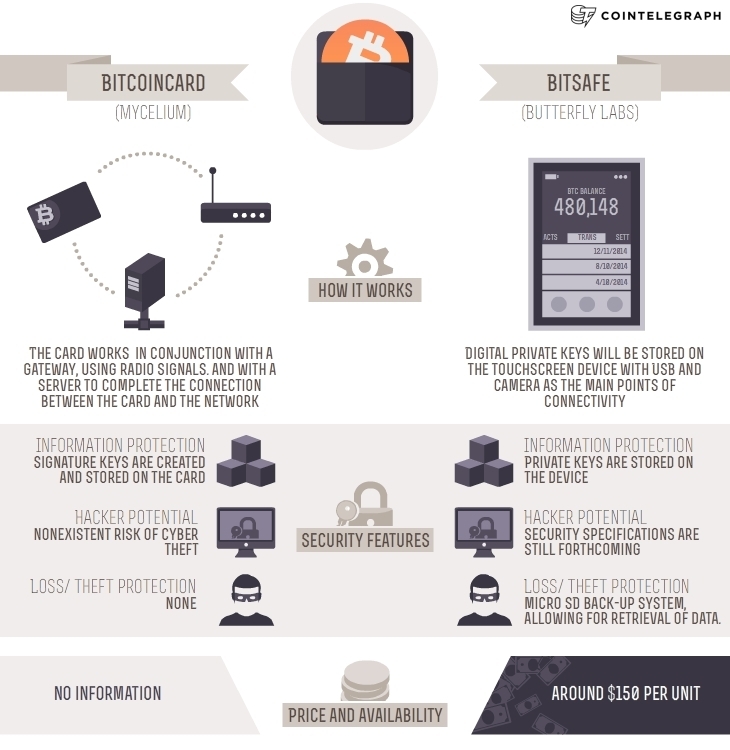
BitStash
BitStash’s storage solution is designed with flexibility and mass consumer use primarily in mind. Three components are included, each one with the purpose of working in a different environment; cold storage, a device-based wallet and a mobile wallet for portable use.
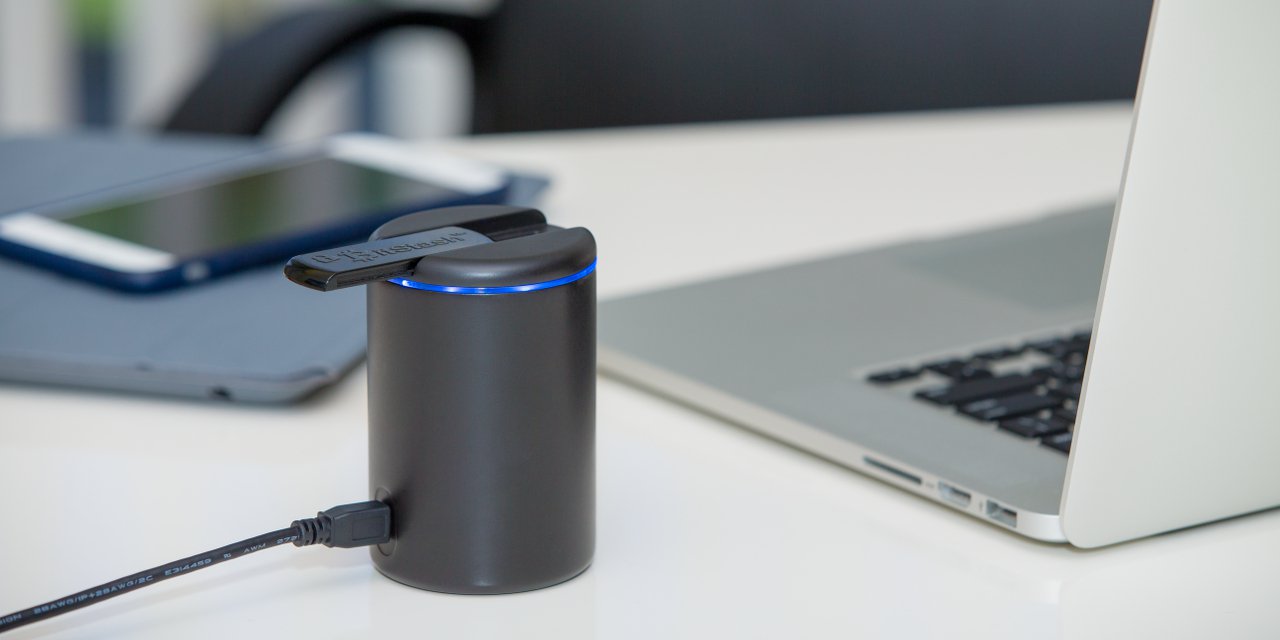
BitStash consists of a physical device which is plugged into a host in order to sign transactions and perform secure wallet functions. Cold storage, in the form of LUKS doubly-encrypted USB devices, can be plugged into this terminal to fund the wallet.
Separately, the mobile wallet resides specifically on a smartphone, and functions as a subsidiary wallet for small transactions, the balance being backed up on the BitStash device. Private keys are also stored here, with balances able to be moved to both BitStash and cold storage using BIP32-generated addresses.
How it works
When using the main BitStash home wallet, a cylindrical device with a multicolored LED ring around the size of an older Nokia mobile phone, a range of security credentials come into play to safeguard balances and secure transactions.
When completing a transaction, BitStash uses a PIN, a Captcha and a unique Color Captcha mechanism to provide a one-off confirmation. The LED ring on the device is capable of displaying a variety of colors.
BitStash will send details to the host via what it describes as ‘hardened’ Bluetooth. The screen requires uses to select the color closest to that displayed on the LED ring in order to confirm the transaction.
Separately, using a second device such as a smartphone requires 2-factor authentication to be used in addition to BitStash’s other security protocols.
BitStash features a fully-functional user interface allowing payments to be reviewed, sent and received in a specially-designed client.

Security features
Information protection: From the security level of each BitStash component to the reinforced hardware used to manufacture it, protection from unauthorized access is a major credential of the BitStash solution. Multisignature transactions are supported. Full details of the extended range of features can be found here.
Hacker potential: In addition to the essential PIN and Captcha procedures, BitStash has a self-destruct feature built in to ensure unauthorized access does not yield access to funds. This includes an automated physical meltdown should any of the hardware be tampered with. Additionally, the device can be configured to become inactive following three unsuccessful password input attempts.
Loss/ theft protection: BitStash is backed up on one or more LUKS-encrypted USB devices, and can be restored with the password as required.
Cointelegraph is currently featuring an interview with CTO Trevor Murphy, in which the full working procedure of BitStash is explained and some popular questions answered, especially those relating to device security.
Price and availability
BitStash is currently open to pre-orders, and the first products are due to be released for shipping in May 2015.
BitStash is available in three forms, plus a version designed for merchants. Prices quoted include a 10% donation to Sean’s Outpost, a Florida-based homeless shelter funded exclusively by Cryptocurrencies.
BitStash, the basic package, costs US$159.
BitStash Ultra, featuring an additional anti-tamper device, costs US$199.
BitStash with FIPS certified features costs US$499.
The POS merchant package costs US$499.
Payment is accepted via major credit and debit cards in addition to Bitcoin.
Ease of use and feedback
As the final product is not available for general testing, the exact user experience is still being fine-tuned as of November 2014.
BitStash’s strong media presence and support network however facilitates in-depth knowledge and answering of queries prior to release.
More information can be found on BitStash’s official website.
[Note: Cointelegraph is expected to receive a physical BitStash device soon. Stay tuned for a full, hands-on review.]
BTChip HW-1
How it works
HW-1 is a USB-powered smartcard which focuses on providing multilayered security for storage of both BTC and any Bitcoin-based cryptocurrency.

The device comes in the form of a tiny attachment to the USB port.
When sending a transaction, HW-1 is plugged into the USB port, whereupon it functions as a keyboard which types the transaction details, along with a unique verification code. This code is required for the transaction to be signed.
The device is designed to be driver-free, and works natively in Google Chrome. Support is integrated into online wallets Electrum and Green Address, with an extensive selection of APIs for further integration.
Security features
Information protection: A password is required each time the device is attached to the USB. A second password option is available, making the first a ‘dummy’ password. There is an inbuilt auto-wipe feature which activates after 3 incorrect password attempts.
Hacker potential: Private keys never leave the device. 2-factor authentication is enabled.
Loss/ theft protection: On first installation, a mnemonic is used to back up the wallet.
Price and availability
HW-1 is currently available from BTChip’s website. As a promotional offer, 2 devices currently cost just 20EUR (equivalent in BTC). Expedited shipping is available for an additional 10EUR.
Ease of use and feedback
Reviews have praised the simplicity of the design, as well as the transaction protocol’s reliability. Criticism has been leveled however at the lack of control over input and output. As such, the device will sign any transaction as soon as it is attached, meaning trust in the host machine required (not the case with Bitsafe, for example). Reviewer David Perry summarizes that the device is sufficient for lower-end transactions and provides adequate security.
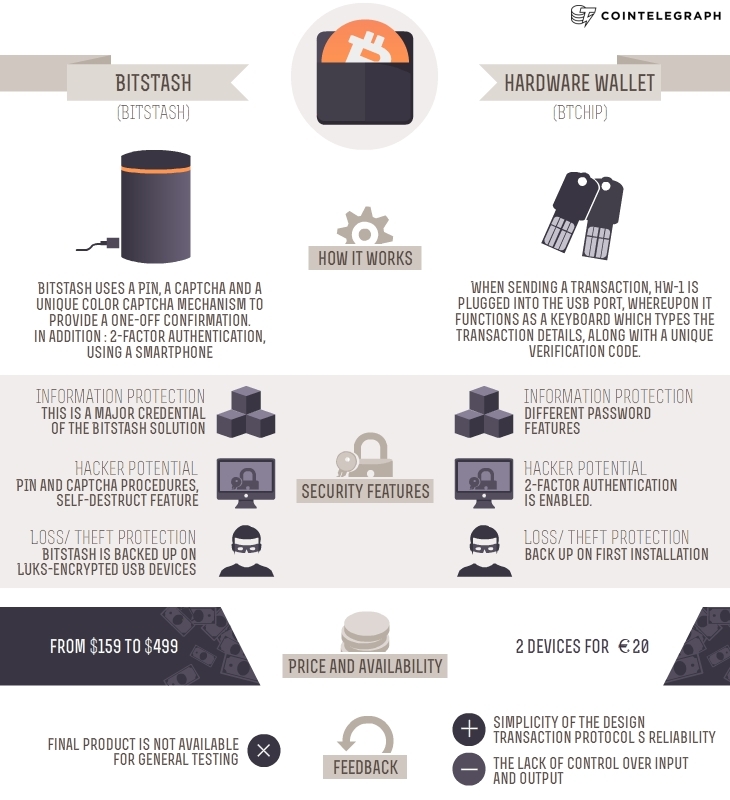
Pi Wallet
How it works
Pi Wallet is essentially an offline notebook-type appliance with removable SD cards which is attached to a host device via USB. The card holds secure information, and is inserted into the notebook, called Raspberry Pi, which handles transaction operations.
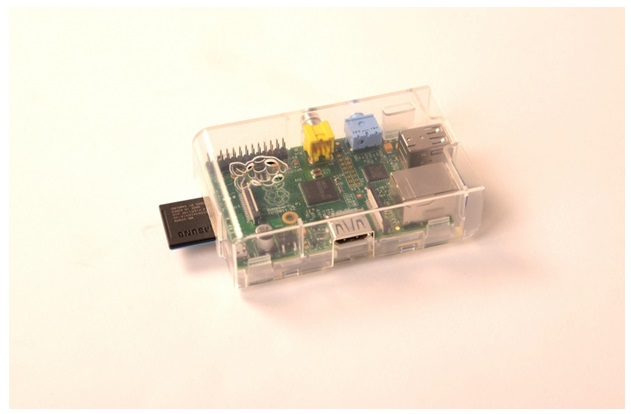
Raspberry Pi is about the size of a large smartphone and comprises only circuitry housed in a transparent plastic case; there is no screen or other interface components.
The device is designed to run with Amory, which allows operations to be executed without exposure of private keys.
Pi Wallet’s website contains extensive tutorials on setup and regular use.
Security features
Information protection: Amory wallet security features extend to the wallet.
Loss/ theft protection: Pi Wallet comes with 2 SD cards, with one used as a back-up. It is also possible to create unlimited paper back-ups as required.
Flexibility: Raspberry Pi can be ordered with or without Amory and operating system Raspbian installed, allowing users to create bespoke security setups.
Price and availability
Pi Wallet currently costs 124.95EUR, payable in BTC, EUR or USD.
Additional SD cards are available for purchase separately if required.
As of October 2014, Pi Wallet is currently sold out with a new batch expected soon.
Ease of use and feedback
The wallet provides high-quality back-up facilities as well as extensive support online. Use of the wallet revolves around attaching Raspberry Pi to a host device, which requires USD and HDMI cables which impacts portability. Reviews have further pointed at the relatively high price and considered whether the level of security warrants the cost. Cables are not included in the price of the device itself.
Trezor
Trezor is a roughly credit card sized USB-driven storage and transaction signing device. Trezor has gained a significant reputation since its launch, combining a range of security and support features.
How it works
Trezor functions as a verification device when connected to the host via USB in much the same basic manner as Bitsafe, but with enhanced security parameters.
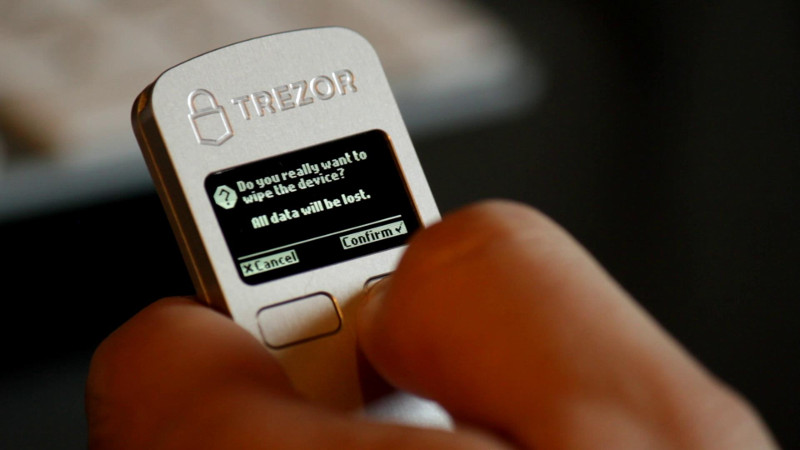
The device contains an OLED screen allowing for transaction verification and enhanced user control of functionality. The screen is also an important security feature in its own right, allowing zero-trust in the host device through rearranging the configuration of keyboard digits, for example.
Password protection is offered in addition to standard mnemonic procedures for back-up, referred to in Trezor as a recovery seed. Trezor is designed so that information is secure regardless of the state of the host device, or whether Trezor itself is stolen.
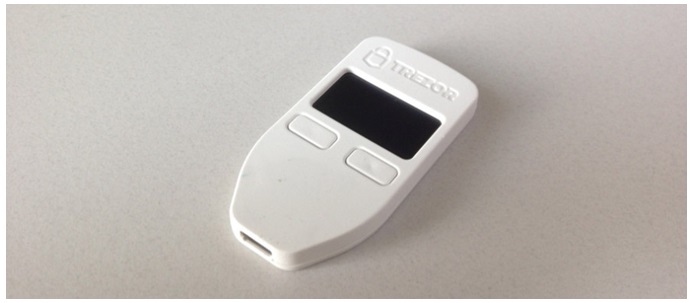
Security features
Information protection: The master key of producer SatoshiLabs is safely guarded; more information is available here.
Hacker potential: Complex generation of a 4-digit PIN for Trezor described above is enhanced in the event of unsolicited attempts to discover it. With each incorrect attempt, the waiting time to try again increases by a factor of 2. With 6561 possible combinations, discovery of the PIN is unlikely.
Trezor’s website contains a large amount of information on a range of possible attack situations. The full list is available here.
Loss/ theft protection: In addition to the PIN, the recovery seed serves to provide a secure back-up for a lost device. Recovery seeds can also be protected with a passphrase.
Price and availability
Trezor is available from official purchasing site buytrezor.com for US$119 (BTC equivalent). Free shipping is available worldwide using this option.
Ease of use and feedback
Overall Trezor has received positive criticism from a range of sources, both in terms of its user experience and reliability. Particularly highlighted is its rendering of complex security procedures simple and efficient. The one drawback noted by David Perry among others is that Trezor, unlike BitStash, its main competitor (see below) cannot communicate with mobile phones.
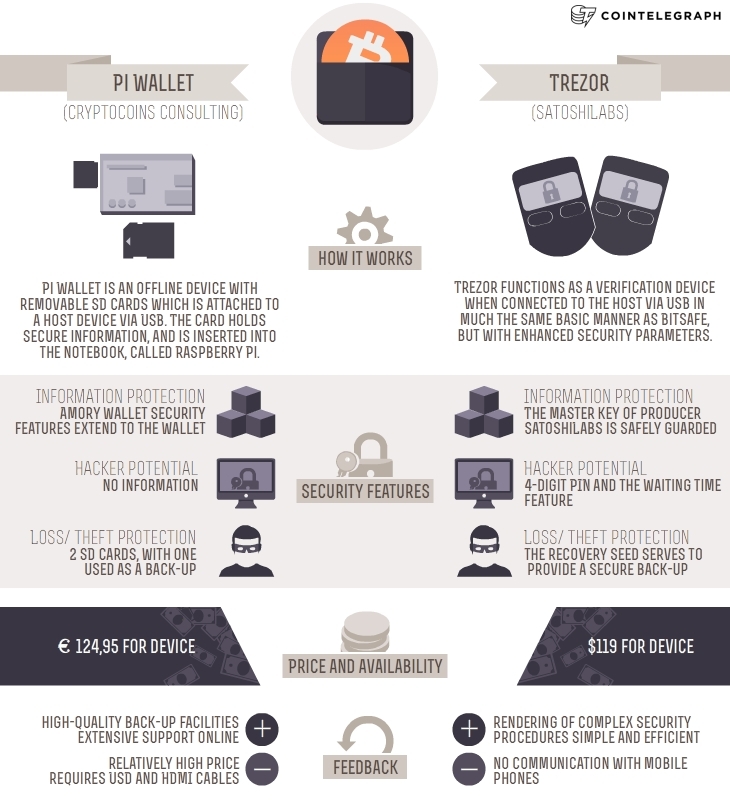
The Verdict
The hardware wallet market is still in its infancy. Of the current offerings, BitStash and Trezor have certainly gained the greatest media presence, but prior to both being publicly available with significant feedback, it is difficult to ascertain their pros and cons.
A major advantage of BitStash is its flexibility; both mobile and static environments are covered with specifically-designed equipment, which perhaps makes BitStash the most logical choice for many modern consumers, businesses and even large-scale Bitcoin operations such as online exchanges.
By any means, these two solutions offer a different class of support from other options on the market. Bitsafe, also from a well-known community entity Butterfly Labs, is still not available and no specific information has been released regarding progress pointing to a high probability of vaporware considering the company’s limited operations due to ongoing legal issues.
As such, BitStash and Trezor must surely be those recommended from the point of view of the all-important consumer support. Together with their wide-reaching security credentials, both should offer a realistically reliable hardware storage solution.
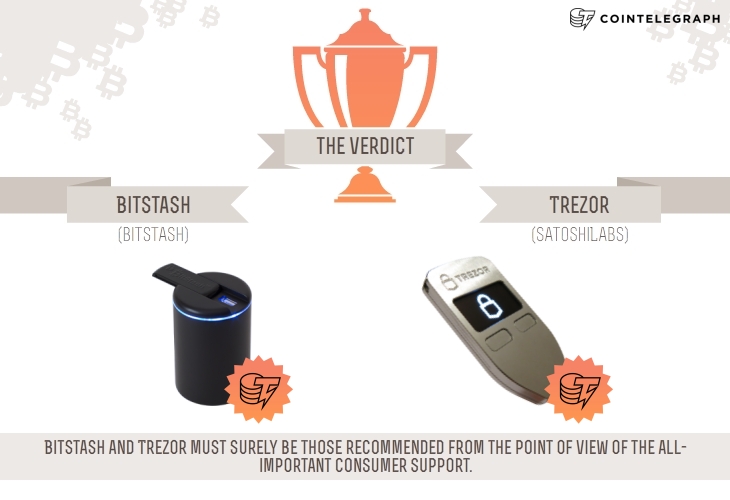
Did you enjoy this article? You may also be interested in reading these ones:
